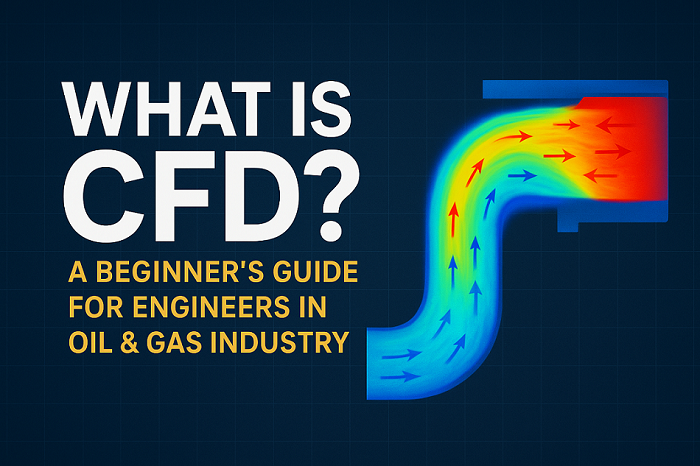
A Beginner’s Guide for Engineers in Oil and Gas provides an introduction to CFD as a computational method.
Engineers working in the oil and gas sector handle numerous complex responsibilities. The management of fluid movement and pressure reduction and thermal regulation requires their expertise. The execution of tasks through traditional methods requires extensive periods of time. The obtained results from these methods often lack precision. People now employ advanced Computational Fluid Dynamics as their preferred solution.
Computational Fluid Dynamics (CFD) represents a computer-based method which analyses fluid behavior. The system demonstrates the movement of heat as well as chemical reaction processes. Engineers use Computational Fluid Dynamics analysis services to evaluate design concepts through virtual testing before physical implementation. The system allows users to observe fluid behaviour within pipes and tank gas distribution and equipment heat management capabilities.
The following guide provides an introduction to CFD fundamentals. The guide explains CFD fundamentals and demonstrates its value for the Indian oil and gas sector.
What Is Computational Fluid Dynamics (CFD)?
The fundamental concept of Computational Fluid Dynamics (CFD) involves using numerical approaches and algorithms to solve and analyze problems that involve fluid flow behavior. The method breaks down physical systems into tiny sections before using fluid motion equations to generate predictive simulations of system performance.
Engineers use CFD to perform virtual testing of their ideas instead of depending solely on physical prototypes. The process enables engineers to obtain valuable information which physical testing methods cannot detect while reducing both time requirements and expenses.
Why Is CFD Important in Oil & Gas?

The oil and gas field has many complicated processes. Fluid movement is an important part of them. The technology provides multiple benefits to engineers through its operation:
- The system optimizes pipeline operations by reducing pressure loss during operation.
- The system optimizes fuel consumption in engines and burners through improved combustion efficiency.
- The system identifies potential locations where equipment components will experience wear and damage.
- The system enhances the separation processes which occur in refineries between different materials.
- The technology enhances both the safety of offshore platforms and underwater systems.
This method helps break down complex systems—like pipelines, tanks, or equipment in oil and gas plants—into small sections, where fluid flow, heat transfer, and chemical reactions are calculated step by step. This way, engineers get a detailed picture of what’s happening inside their designs, all before anything is physically built.
Why Is CFD So Useful for Engineers?
In the oil and gas industry, managing fluids is a huge deal. Think about controlling pressure, temperature, and flow in pipelines or machines. Doing this the old-school way can take ages, cost a fortune, and sometimes still be not precise enough. CFD changes the game by making everything faster, cheaper, and way more reliable.
Here’s a quick look at how it helps:
- Cost Savings
Instead of building multiple expensive prototypes, engineers test their ideas in the digital world. It’s like trying different recipes on a simulator before making the real cake. Way less waste, way less cost. - Time Efficiency
Testing different design scenarios used to take weeks, but now, engineers can run them in parallel on computers. So projects don’t drag forever. Everything gets decided faster, saving a ton of time. - Improved Safety
One of the coolest things about CFD is that it can predict where equipment might fail or where dangerous conditions could show up before they actually do. No more nasty surprises during operations. - Performance Optimization
Why guess when you can know? CFD helps engineers fine-tune systems so they work at peak efficiency. It’s kind of like adjusting your car’s engine for maximum fuel economy and power, just way more advanced.
The Role of CFD Consulting Companies in India
Not every company has the in-house brainpower or high-end computers needed to run these super detailed CFD simulations. That’s exactly where CFD consulting companies in India come in.
These specialists bring advanced software, experienced engineers, and deep knowledge of fluid dynamics to the table. Oil and gas companies don’t need to spend millions building their own CFD department. Instead, they can just partner with the pros and get accurate, fast results without all the heavy investments.
It’s a smart move because it gives access to world-class Computational Fluid Dynamics analysis services while letting the experts handle the tricky stuff.
What’s Next for CFD in Oil & Gas?
CFD isn’t slowing down. With AI and cloud computing becoming the new normal, simulations are getting faster, smarter, and more accurate. In India especially, more companies are jumping on board because it’s the easiest way to cut costs, improve how systems run, and keep everything super safe.
Final Thought
For engineers in oil and gas, CFD isn’t a “nice to have” anymore. It’s a must-have. Helps predict fluid behavior, optimize designs, and stop expensive failures before they happen.
Whether companies use their own tools or team up with CFD consulting companies in India, having Computational Fluid Dynamics analysis services makes operations smarter, safer, and just way more efficient.
At the end of the day, using advanced computational fluid dynamics helps oil and gas companies stay competitive, cut risks, and get better performance from every project. Simple as that.
FAQs
Q1. What is Computational Fluid Dynamics (CFD) in oil and gas?
CFD is a computer-based method that simulates fluid flow, heat transfer, and chemical reactions to help engineers analyze and optimize oil and gas systems before building physical prototypes.
Q2. Why is CFD important for oil and gas projects in India?
It helps optimize pipeline operations, improve combustion efficiency, enhance equipment safety, and reduce operational costs—making projects faster, safer, and more reliable.
Q3. How does CFD save time and costs for engineers?
Instead of building multiple prototypes, engineers run virtual simulations, allowing faster testing, fewer design errors, and significant savings in project expenses.
Q4. What role do CFD consulting companies in India play?
They provide advanced software, expert engineers, and simulation services, enabling oil and gas companies to access high-quality CFD analysis without heavy in-house investment.
Q5. What is the future of CFD in the oil and gas sector?
With AI and cloud computing, CFD simulations are becoming smarter and faster, helping companies in India improve efficiency, safety, and competitiveness in global projects.

Krupal Patel
Krupal Patel is the CEO of Neocent Engineering Pvt. Ltd., Ahmedabad, specializing in advanced engineering solutions. With over 8 years of expertise in Product Design, FEA, CFD, and ASME-BPVC stress analysis, he has successfully delivered high-precision projects across pressure vessels, piping, and structural systems.
